Zakkokumai: Rice with seeds and grains and bits
[Update:] There seems to be some confusion about how zakkokumai is cooked and looks like, so I've added some more photos and such.
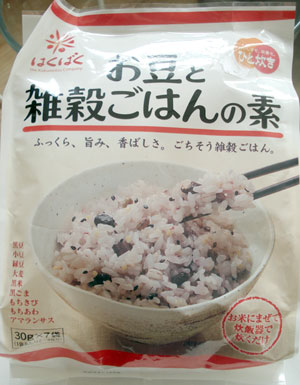 Rice is such an integral part of a Japanese meal, that the word for 'meal' (gohan, ご飯) also means rice. White rice is the norm, both for taste and for various cultural reasons. But as you probably know, white rice (hakumai, 白米) is rice that has been stripped of most of its nutrients, leaving just the starch.
Rice is such an integral part of a Japanese meal, that the word for 'meal' (gohan, ご飯) also means rice. White rice is the norm, both for taste and for various cultural reasons. But as you probably know, white rice (hakumai, 白米) is rice that has been stripped of most of its nutrients, leaving just the starch.
Brown rice (genmai) is the obvious healthier alternative. But brown rice can take some time to cook, what with the soaking and so on that's needed, and some people simply don't like the taste or texture.
In recent years, something called zakkokumai (雑穀米)has become increasingly popular in Japan. Zakkoku just means "mixed grains", and mai is rice. Another name for essentially the same thing is kokumotsu gohan (穀物ご飯). It's rice that has a small amount of various grains and seeds mixed into it prior to cooking. You can then cook the rice in a rice cooker in the normal way. The grains and seeds add a mix of nutrients and fiber, and a little flavor too.
Zakkoku or kokumotsu mixes are sold in convenient packets. Here are two kinds; each pack is meant to be used for 2 to 3 cups (rice cooker cups) of white rice. You simply throw in the contents after you've washed the rice and put in the water for cooking.
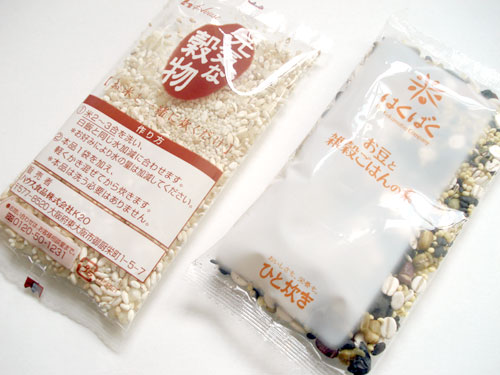
The light colored one contains sprouted brown rice, pressed barley, hatomugi (Job's Tears), millet (uruchi hie), and white sesame seeds. The package touts the fact that the whiteness of the rice is maintained, even after you mix in the zakkoku.
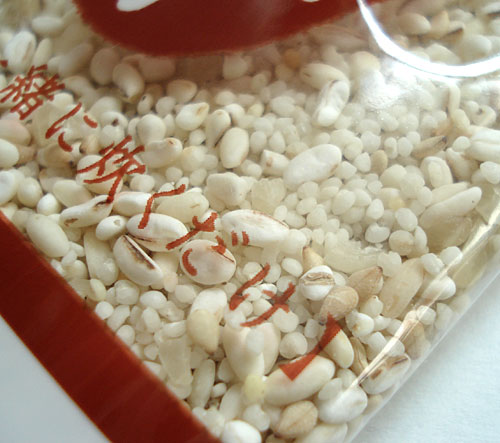
The second one has black beans (kuromame), azuki beans, mung beans, pressed barley, black rice (kokumai), another kind of millet (mochikibi), yet another kind of millet (mochi hie) and amaranth. It colors the rice when cooked a slight reddish-purple.

The good news is, these zakkoku packs are now more available outside of Japan. I've seen one kind at my local Japanese grocery, Nishi's, and and Japan Centre carries them too (link to the 'white' kind, and another kind here.) The bad news is that for those of us buying these kinds of things overseas, they are pretty expensive.
If you're interested in trying out zakkoku-mai, look for these convenient packs at your favorite Japanese grocery store. If you can't find them though, try making your own mix of various grains and seeds, and add about a tablespoon per cup of rice.
Here's a mix that I can easily assemble with ingredients from a regular supermarket and health food store:
- Black beans
- Azuki beans (but beans may need to be pre-soaked)
- Lentils
- Millet
- Quinoa
- Barley
- Sesame seeds
- Steel cut oats
- Amaranth
At the very least, it's an interesting alternative to brown rice.
(A sidenote: I'm always reluctant to talk about Japanese ingredients unless it's actually available outside of Japan. Zakkoku-mai mixes weren't available until fairly recently, but now they are, so here they are.)
Update: Cooking zakkokumai, with photos
To clarify some confusion about exactly how a zakkoku-mai mix work, here are some photos of it being cooked.
After washing 2 rice-cooker cups of rice, I added a packet of zakkokumai mix (this is the one with beans and things in it, described above) to the rice cooker with the water. There are about 2 tablespoons of mix in a packet.
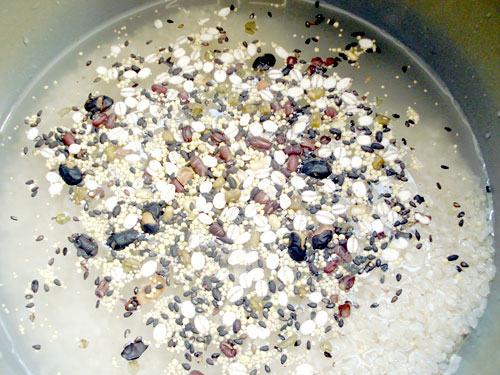
Here's how it looks after it's been cooked. I used the regular white rice setting, not brown rice or anything else! The mix is sort of clumped up in one corner, so I fluff up the rice to distribute things evenly.
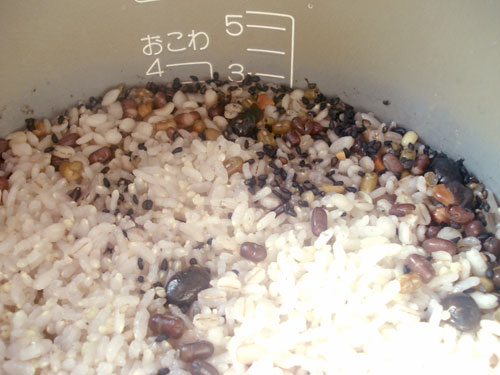
Here's how a bowl of cooked zakkokumai looks like. This mix puts a reddish color cast on the rice because it contains azuki beans and black rice, but the 'white' kind of mix puts no color on the rice.
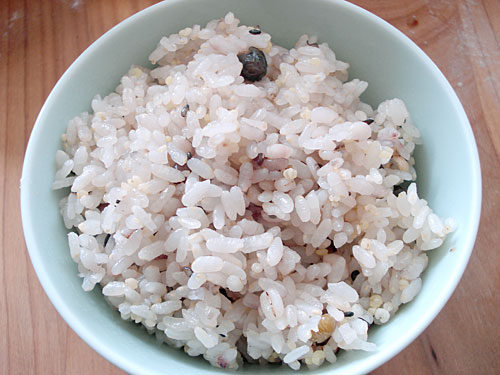
You may not care what color your rice is. But it may matter a lot if you happen to have older Japanese people to feed, who may have an aversion to any kind of rice that isn't white. (My stepfather is like that, and to a lesser extent my father too. It all has to do with the era in which they grew up, when white rice was highly desirable and any deviation from it brought back bad memories of rationing and food shortages during and after the war, when things like millet were used as rice substitutes. Ironic that now these formerly undesirable rice substitutes are seen as health foods!)
Here's how the cooked rice looks close up.
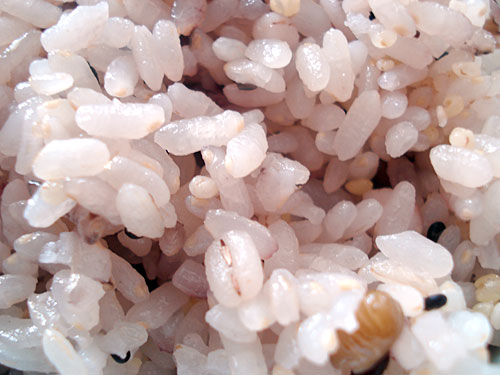
It doesn't taste significantly different from plain white rice, though there is some texture interest. There's no need to devise special meals to eat it with either. We actually at this rice last night with curry.
In any case I hope the photos make the use of zakkokumai a bit clearer.
If you enjoyed this article, please consider becoming my patron via Patreon. ^_^

 Welcome to Just Hungry, where we serve authentic Japanese recipes and more! I'm
Welcome to Just Hungry, where we serve authentic Japanese recipes and more! I'm 














Comments
freddy
21 February, 2008 - 18:22
Permalink
Another zakkoku mai recipe
I made a zakkoku mai recipe from Elizabeth Andoh's Washoku: equal parts barley, quinoa, amararanth (I didn't add this), sesame seeds, flaxseeds, oatmeal, and/or poppy seeds. I added in some black rice I had too. I add about a tablespoon per cup of raw rice. It's really good. Because of the black rice, it turns the final dish purple, which is interesting.
sunny
21 February, 2008 - 18:47
Permalink
Zakkoku proportions?
Any hints on the proportion of starches to legumes on this?
anon.
21 February, 2008 - 19:02
Permalink
Zakkoku-mai & Rice Cooker
I have one of the neuro-fuzzy Zojirushi rice cookers and was wondering what setting I would use to cook this type of rice mixture? Would it be mixed, brown...?
anon.
3 February, 2010 - 05:43
Permalink
Re: Zakkoku-mai & Rice Cooker
I don't have a rice cooker, but due to the longer cooking sorts of grains and rice (I've made this in a pan - YUMMY!) I'd say the brown rice setting. It takes quite a while to cook and boy is it worth it!! No more boring white rice!! Can't believe what I missed being raised on Minute Rice - LOL
Nico
21 February, 2008 - 19:08
Permalink
That sounds very hearty and
That sounds very hearty and satisfying. Do you find that the mix of flavors in your zakkoku go with everything, like rice does, or are there certain combinations of zakkoku + other dishes that work better than others?
maki
21 February, 2008 - 20:58
Permalink
sunny, the package doesn’t
sunny, the package doesn't say, but as freddy says, try equal proportions of say 3-4 different grains and seeds and see how it goes.
anon, the zakkoku mixes can be used in rice with the regular white rice setting.
Nico, zakkoku rice goes with anything that regular rice does. The taste tends to be a bit 'nutty', so the tendency is to want to serve it as part of a generally vegetable-oriented/healthy meal.
jn
22 February, 2008 - 04:23
Permalink
some kashi brand pilaf?
Sounds like you could throw a handful of Kashi brand pilaf into the rice and accomplish something similar. It contains buckwheat, triticale, rye, hard red winter wheat, barley, oats, long grain brown rice, and sesame seeds.
Wakkun
22 February, 2008 - 05:38
Permalink
do the beans need to be soaked - how long?
Maki - hi! I see on the azuki beans, you said, may need pre soaking, how about the black beans? If so, how long? I have no experience with cooking beans at all. Thanks.
I don't recall seeing zakkoku packets in the Japanese grocery store I go to, but at the asian grocery stores, I see a lot of this kind of rice packets from Taiwanese companies.
maki
22 February, 2008 - 11:32
Permalink
jn, the kashi pilaf sounds
jn, the kashi pilaf sounds like a good mix (as long as it's not pre-flavored).
Wakkun, now that I think of it, the beans may have to be pre-cooked before adding...because logically even long-soaked beans would not cook within the 15-20 minutes it takes for rice. So I am guessing the ones in the mixes are precooked and dried. I guess you could use canned beans instead, or some kind of pre-cooked beans (there are lots of sweet and sort of semi-dried beans in Japanese stores...and I think similar in Chinese etc. stores...)
Sarah
22 February, 2008 - 19:44
Permalink
Rice cooker
Hasn't anyone made this in a rice cooker? I'm really curious to know what setting to use, too. Anyone??
maki
23 February, 2008 - 14:18
Permalink
Sarah, I’ve added photos
Sarah, I've added photos to the original article which should make things clearer. You just use the regular white rice setting.
Sarah
23 February, 2008 - 19:51
Permalink
re: Rice Cooker settings
Thank you, Maki. That explains things!
army_kitten
23 February, 2008 - 23:53
Permalink
zakkokumai with brown rice?
hi maki!
i was wondering whether it is possible to make oshi mugi genmai gohan in a rice cooker? i have made zakkokumai using beans (azuki beans or a bean mix i get at a local korean market) or pearled barley with brown rice, but recently i bought a bag of oshi mugi that i really want to try out. all of the recipes i've found for pressed barley w/rice involve white rice, though, and so i'm not sure whether it's too processed to withstand the much longer cooking time. do you know if i'll end up with brown rice and barley mush?^^;;
@Wakkun: even with the brown rice setting, beans that have not been pre-cooked and dried still need to be pre-soaked (or at least they do with my rice cooker). according to my roommate, you should soak most beans for around 6 hours in the summer and around 12 hours in the wintertime—though it also probably depends on how warm your kitchen is, too. :3 if you're only using azuki beans, they don't need to be soaked as long—maybe half that time?
maki
25 February, 2008 - 12:23
Permalink
I guess that the zakkoku
I guess that the zakkoku mixes are geared towards shorter cooking times, but you could work around that by soaking the brown rice well (so that it cooks fast) and then adding the zakkoku mix just before you switch on. But it probably won't make a drastic difference if you just add things all at once. Try it out!
ode
24 February, 2008 - 11:31
Permalink
Special Rice
Hi Maki,
I like to use the black long grain rice and mix it with brown, the more the rice is cleaned the less of the purple color soaks in.
I think it adds a nutty flavor to the every day rice. I also do it a little South Asian and use cinnamon sticks, cardamom pods, and golden sultans.
Everything goes in my handy dandy rice cooker and I have almost a meal when its done.
I am going to try your suggestions, by the way the frozen tofu poached in vegetable broth and then fried with your teriyaki flavoring was a hit! Thanks!
Ciao,
O
Mark
25 February, 2008 - 01:40
Permalink
Brown rice in a rice cooker
We have no problem cooking brown rice in a rice cooker, even on the speed setting (hakumei kyuusoku).
LIling
1 March, 2008 - 08:45
Permalink
Brown rice
Recently, I started eating brown rice, and surprisingly I enjoyed it very much. On lately, I decided to add sweet potato to the brown rice and it tasted just as delicious!
Might consider adding other grain the next time.
jani
5 April, 2008 - 22:22
Permalink
I haven’t seen the white
I haven't seen the white mix around, but I do get the other one frequently, cook it in the rice cooker with 3 cups of rice and love it!
anon.
17 April, 2008 - 17:24
Permalink
i have often seen the mixes
i have often seen the mixes in korean grocery stores and sometimes in chinese. not as much in japanese. so if you can't find these in a japanese grocery store, try a korean one.
anon.
18 April, 2008 - 01:22
Permalink
The rice i use at home comes
The rice i use at home comes in a package with, i think, eight different kinds of rice and grains. it has different kinds of purple, red, black, and brown rice, and barley and stuff. We combine this mixture with brown rice in our rice storage thing so that it is already pre mixed. I think the only difference with cooking it is that we use more water and let it sit for longer before opening the rice pot and eating it. I have an old rice cooker so theres no setting, just one switch for cook. My mom always manages to make it perfectly but mine always come out a little too dry or too wet. haha, i need more practice.
anon.
18 April, 2008 - 01:45
Permalink
the rice i use at home (edit)
i wanted to add that my rice comes out a pretty dark reddish color. sort of purplish reddish brownish. sometimes we add red beans or corn and stuff too.
Spunky
6 May, 2008 - 07:10
Permalink
thanks maki
Thank you so much for such an amazing blog,maki!
I would like to testify that consuming brown rice actually do helps in weight maintainance and weight loss.I'm currently a nutrition student studying overseas and sometimes do miss those food back home,[from south east asia btw].Ever since i read your blog and other nutritional articles about brown rice, i decided to give it a try since i'm a person who used to exclude white rice from my diet.
The brown rice is normally prepared with zakkoku, i just love the texture and flavor of it. Besides,the unpolished grains help me to get through almost all day long without any thoughts for reaching out for snacks ^^ I feel healthier than ever and not being tried easily as i used to,even my host kiwi mother realised that and jeans hanging loose ard me now!
maki
6 May, 2008 - 07:30
Permalink
fiber
congratulations on your weight loss! Fiber really is great for filling you up. Brown rice + zakkokumai = wow.
Della
9 September, 2008 - 16:58
Permalink
Zakkokumai: Rice with seeds and grains and bits
I was able to purchased the same package of grains (as shown on the 1st photo, showning a bowl of rice and mixed grains on the packaging). I tried it today and make it with 3 cups of short-grain brown rice and using 1-1/2 package of mixed grain. I love it. I love the taste and texture of the rice. I enjoyed the rice eaten just plain on its own.
I'm surprised someone haven't come up with a do-it-yourself multi-grain/seed mix. It seems to be very simple to mix your own mix. What are your thoughts?
Della
9 September, 2008 - 17:07
Permalink
Zakkokumai: Rice with seeds and grains and bits
Sorry: If I read the entire blog above, I would have known that you have already explained about making your own mix and adding a tablespoon of mix per cup of rice. Each packet consists of 3 tablespoons of mix. I used 4-1/2 tablespoons of mix for 3 cups of brown rice. I think I will try making my own mix. Thank again for your post.
TJ
18 September, 2009 - 16:42
Permalink
Re: Zakkokumai: Rice with seeds and grains and bits
I have been frantically searching for the standard nutritional table values for Mixed Grains. I realize they will vary based on exactly what the mix is. But do you have the table that I can use as I need it to monitor strict dietary requirements (the one on the package I got is completely incorrect!) Thanks.
Eneri
7 September, 2010 - 02:57
Permalink
Zakkokumai: Rice with seeds and grains and bits
Hi Maki, your blog is really complete and I found myself trying a lot of the recepes. I want to ask you, I do not have a rice cooker and I cook most of the time genmai, if I make the mix myself, for cooking, the cantity of water is the same?
Keep the good work,
maki
7 September, 2010 - 14:00
Permalink
Re: Zakkokumai: Rice with seeds and grains and bits
With the small amount added as suggested there's no need to adjust the amount of water. Just cook your rice as normal and it will work.
Esther
9 October, 2012 - 22:57
Permalink
Re: Zakkokumai: Rice with seeds and grains and bits
I've made this kind of rice on the white rice setting of my rice cooker. Turned out fine and you don't need to soak the beans from the ZSakkokumai packets.
anon.
4 June, 2013 - 19:03
Permalink
Re: Zakkokumai: Rice with seeds and grains and bits
I've made brown rice with beans using maki's pressure cooker instructions and it came out perfect. I used mixed dry beans from a korean market. Soaked a 1/2 cup overnight. Here's what I did:
1. In a bowl mix in 1/4 cup of sweet brown rice, 1/2 cup of mixed beans,
1 1/4 cup of brown rice. Rinse a few times, then soak for 1 hour,
2. Cooked the above using maki's instructions: using the pressure cooker, get it up to pressure then cook for 25 mins. I left it to go down to pressure naturally and it came out great!
Hope that helps someone! I'm searching for other ways to use my mixed dry beans. Any suggestions are appreciated!
-Cobie
susanne
15 April, 2014 - 21:35
Permalink
Re: Zakkokumai: Rice with seeds and grains and bits
That's an interesting story about white vs. brown rice.
My father was the same on the bread side. He only would eat white bread, since he had to eat whole wheat flour bread during world war 2 (they were farmers, used their own grains, baked their own bread, probably without the shelfing and some other restrictions like ration stamps the non-farmer population had).
As kids we had a hard time to buy the whole wheat bread since he loathed it, even though we loved it!
My mother too had to eat this kind of bread during the war, they either could buy whole wheat flour with the ration stamps or get it from the bakery which had to shelf it for 3 days in order that people wouldn't eat too much bread at once...
But nevertheless, she still enjoyed it.